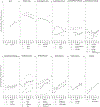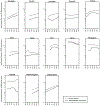International trends in hepatocellular carcinoma incidence, 1978-2012
- PMID: 31597196
- PMCID: PMC7470451
- DOI: 10.1002/ijc.32723
International trends in hepatocellular carcinoma incidence, 1978-2012
Abstract
Primary liver cancer, the major histology of which is hepatocellular carcinoma (HCC), is the second leading cause of cancer death worldwide. We comprehensively examined recent international trends of primary liver cancer and HCC incidence using population-based cancer registry data. Incidence for all primary liver cancer and for HCC by calendar time and birth cohort was examined for selected countries between 1978 and 2012. For each successive 5-year period, age-standardized incidence rates were calculated from Volumes V to XI of the Cancer Incidence in Five Continents (CI5) series using the online electronic databases, CI5plus. Large variations persist in liver cancer incidence globally. Rates of liver cancer remain highest in Asian countries, specifically in the East and South-East, and Italy. However, rates in these high-risk countries have been decreasing in recent years. Rates in India and in most countries of Europe, the Americas and Oceania are rising. As the population seroprevalence of hepatitis B virus (HBV) continues to decline, we anticipate rates of HCC in many high-risk countries will continue to decrease. Treatment of hepatitis C virus (HCV) is likely to bring down rates further in some high-rate, as well as low-rate, countries with access to effective therapies. However, such gains in the control of liver cancer are at risk of being reversed by the growing obesity and diabetes epidemics, suggesting diabetes treatment and primary prevention of obesity will be key in reducing liver cancer in the longer-term.
Keywords: cancer registry; epidemiology; incidence rates; liver cancer.
Published 2019. This article is a U.S. Government work and is in the public domain in the USA.
Conflict of interest statement
Figures






References
-
- Bray F, Ferlay J, Soerjomataram I, Siegel RL, Torre LA, Jemal A. Global cancer statistics 2018: GLOBOCAN estimates of incidence and mortality worldwide for 36 cancers in 185 countries. CA Cancer J Clin 2018;68:394–424. - PubMed
-
- Bertuccio P, Turati F, Carioli G, Rodriguez T, La Vecchia C, Malvezzi M, et al. Global trends and predictions in hepatocellular carcinoma mortality. J Hepatol 2017;67:302–9. - PubMed
-
- Global Burden of Disease Liver Cancer , Akinyemiju T, Abera S, Ahmed M, Alam N, Alemayohu MA, et al. The Burden of Primary Liver Cancer and Underlying Etiologies From 1990 to 2015 at the Global, Regional, and National Level: Results From the Global Burden of Disease Study 2015. JAMA Oncol 2017;3:1683–91. - PMC - PubMed
-
- Liu Z, Jiang Y, Yuan H, Fang Q, Cai N, Suo C, et al. The trends in incidence of primary liver cancer caused by specific etiologies: Results from the Global Burden of Disease Study 2016 and implications for liver cancer prevention. J Hepatol 2019;70:674–83. - PubMed
Publication types
MeSH terms
Grants and funding
LinkOut - more resources
Full Text Sources
Medical
Research Materials

